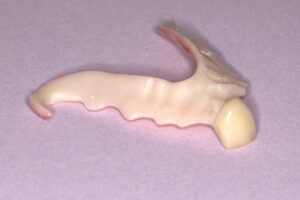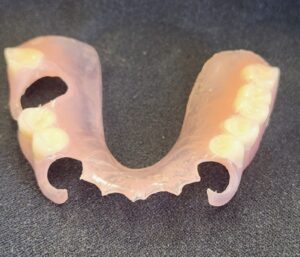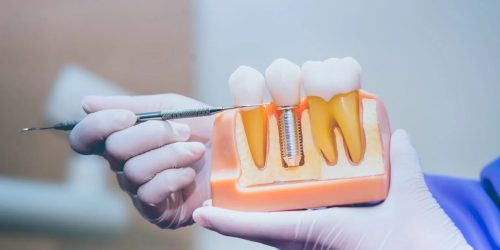The ULTIMATE Guide to Partial Dentures for Front and Back Teeth
Partial dentures are one of the most common treatments for replacing missing front or back teeth. With so many different options with different intended uses, however, patients may experience confusion.
Partial dentures serve the basic purpose of replacing missing teeth by using metal or acrylic that rests on your gums. They are typically secured in place by attaching to other teeth.
There are different types of partial dentures for front and back teeth available. Some are made of durable metal and can replace multiple missing teeth. Others, like single tooth dental flippers, are mainly used for cosmetic purposes. They are made of different materials, and they can vary in price quite a bit.
Partial dentures are one of the most common treatments for replacing missing teeth. There is often confusion surrounding them for patients because there are many different options with different intended uses. Their basic function is to replace missing teeth with metal or acrylic that sits on your gums, and they stay in place usually by attaching to other teeth. They vary from strong metal that can take a beating and replace many missing teeth, to single tooth dental flippers that are just meant for looks. They are made of different materials, and they can vary in price quite a bit. I’d like to take a deep dive into the functions of a partial denture, the different kinds of upper partial dentures and lower partial dentures, how they fit, when you can and can’t do them, how they are made, how to take care of them, and my own personal opinion on them in general. I’ll also talk about alternatives to partial dentures that may work better for some folks.
What Can a Partial Denture Do?
A partial denture serves one main function, to replace missing teeth. It is what we call a “removable” option because it is removed by the wearer (you) regularly to be cleaned. It comes in and out. There are ultimately 3 reasons to replace teeth that are missing:
- Aesthetics – You want to look better because you don’t like having a space where there should be teeth.
- Eating – You are having trouble chewing because of teeth that are missing.
- Keeping a tooth space the right size – Let’s say, for example, you are missing one tooth, and you can’t afford a dental implant right now. You plan on saving some money so you can afford one in the near future, so your dentist makes you a flipper tooth to wear while you save up money. If you leave the space empty and don’t wear a dental flipper, there is a high chance that your teeth can shift and either make the space bigger or smaller, which can lead to a weird looking tooth that is the wrong size when you get your dental implant down the road.
Truly, there is a 4th reason as well, which can be a little complicated, but I will try to keep it simple. If you are missing back teeth, it’s like having a house on a bad foundation. Front teeth aren’t meant to take the forces of chewing all by themselves, so you can have issues with teeth moving or breaking because of missing back teeth. Using a removable partial denture to replace those missing back teeth can prevent bad things like this from happening.
Let’s go over the different kinds of partial dentures and their specific uses.
What Do Partial Dentures Look Like?
What is a Dental Flipper?


Sometimes called a flipper tooth, dental flipper, tooth flipper, single tooth flipper, or just a flipper. It is mainly used to temporarily replace one missing tooth, or a couple of teeth. It almost always only replaces front teeth. It is thin and low profile, and usually made from acrylic with no wires to help hold it in. It is meant to be as low profile as possible, and is mainly used for buying time. “Why is it temporary?” you may ask. Well, using a partial denture to replace one missing tooth, especially a front tooth, doesn’t work very well for a long period of time. Dental flippers often aren’t very stable, they are almost impossible to eat with, and many people end up not wearing them much because they can be a little annoying. They are very useful, though.
Here is an example of when they can shine. Let’s say you get in a car wreck and get a front tooth knocked out. You go to your dentist, and you tell her you want to replace the tooth with something that doesn’t come in and out. You want something solid that will stay in and treat like a normal tooth. Your dentist offers you a bridge and a dental implant as options. The problem is, both are quite expensive. It’s a front tooth, though, so it’s worth the money to you. You talk to your dentist about how you want to do one of those options, but you can’t afford it at the moment, and you’ll need to save up for a few months. Your dentist understands, and introduces you to my good friend, the dental flipper. It will fill the space so others don’t see an empty space when you smile and talk, and it will keep the space the same size so that when you get your dental implant tooth it will still be proportional to the other teeth in your mouth. It may be a little annoying to deal with for a few months, but the benefits far outweigh the negatives.
It can replace more than one missing front tooth, but the more missing teeth it replaces, the harder it is to wear, generally. This is because it doesn’t stay in as well with more missing teeth. It is the most affordable option for replacing a single missing tooth.
What is a Resin Partial?

Let’s move on to the resin partial. Also called an acrylic partial, partial denture, removable partial denture, or a partial denture for back teeth. These partial dentures are made of gum colored acrylic and usually have some sort of wire that fits around your teeth that help them stay in. They can be used to replace any amount of missing teeth, provided there are other teeth still in the mouth for the metal wires to hold on to. They are thicker and stronger than a dental flipper. They can be used short term or long term. They look good, and are generally lower profile, but weaker, than the metal partial, which we’ll talk about next. They typically cost more than a flipper, but less than a metal partial.
What is a Metal Partial?


Now, on to the finest of them all, the metal partial denture. It is often referred to as a cast metal partial or just a partial denture. It is made of a metal “framework” that is covered in gum colored acrylic. It is the strongest and also does the best job of staying in place. It has metal clasps around remaining teeth, which are like little metal arms that hold onto the teeth that you still have. It replaces multiple teeth, and it is meant for the long term. It is always meant as a more permanent option. Sometimes, teeth are adjusted to make it fit better, and your dentist may recommend placing a crown on some teeth in order to improve the fit as well. It is a good looking option that is intended to be used for the long haul. It is the most expensive of the partials, but it provides the best value.
What Other Partial Denture Options Do I Have?

Valplast partials – Valplast is a material that is sometimes used for partials. I generally don’t recommend them because they can’t be repaired and teeth can’t be added to them.
Flexible partials – These are similar to Valplast and have the same disadvantages. Some patients like them because of the flexibility, but I generally don’t recommend them for most situations. They can sometimes be used in place of flippers. An advantage is that they have pink flexible clasps instead of metal ones.

How do partial dentures fit?
I wanted to spend a little time talking about how partial dentures stay in your mouth for front and back teeth. I’ll also touch on how well you may be able to eat with them, and what factors come into play for eating. It’s important to remember that partial dentures have to come in and out. This means that we dentists have to try to make it stay in as good as we possibly can, while also keeping in mind that you will have to take it in and out daily to make sure it stays clean.
The way partial dentures stay in is by holding on to other teeth. There is an assortment of different clasps, wires, and other techniques that are used to accomplish this. The shape of the tooth matters, the way you bite matters, the way your teeth fit together affects the fit, and multiple other factors can influence the fit as well. The point is, there is a lot of variation in partial denture fit and it is different for everyone. There are patients that love their partial and think it fits great, and there are patients who aren’t very happy with theirs.
Eating with partial dentures can sometimes be difficult. If your teeth aren’t shaped favorably, or your bite is unfavorable, then your partial denture may move around slightly when you chew. It all depends on how well the partial fits to your gums and teeth. Even with a perfectly fitting partial denture, some foods can dislodge it. Sticky or very hard foods can be difficult to eat no matter what. You have to remember, it IS made to come out, too.
Also, over time, the fit can change. If your gums shrink, bone under the gums shrinks, or the tooth starts to wear down, it can become loose. Sometimes you may need to get a new partial denture made. Over time, or if you eat hard/sticky foods, the partial denture can break or a tooth can pop off. I have good news, though, they can often be repaired.
How Do I Repair Broken Partial Dentures or Missing Teeth?
Like any object we use regularly, it may break, wear down, or even need to be replaced at some point. Chewing and biting are literally meant to tear things apart. That means teeth, partial dentures, dental flippers, and anything else in the mouth is always taking a beating. So, when that happens to a partial denture, what can be done?
- Missing or broken off tooth – Crunch!!! You are eating something soft, and all of a sudden, it feels like you are biting into a rock. You pull this “rock” out, and it’s a tooth from your partial!! You rush over to your dentist and ask what can be done. Good news! Your dentist says they can “glue” it back in with acrylic. About 30 minutes later, your tooth is back in place and you are back in action.
- Broken partial denture – It’s been a long day at work and you’re finally winding down and about to hit the hay. You clean up your partial with soap and water and reach to put it in its case. Your hand bumps the countertop and, oh no, you drop your partial and it breaks in two! You call your dentist the first thing the next morning, and, just like above, your dentist is able to fit you in and put it back together with that magic acrylic.
One thing to keep in mind about anything that is repaired: anything that gets repaired will ALWAYS be weaker than the original product. This goes for anything in life, but especially something that takes a beating daily. A repaired partial denture is always at a higher risk of breaking again than a freshly made partial that hasn’t broken. If it keeps breaking after multiple repair attempts, it likely needs to be remade.
The above two scenarios are what we dentists hope for when a patient calls with a broken tooth or partial denture. Unfortunately, we aren’t always that lucky. There are many scenarios where a partial can’t be repaired for a multitude of reasons. Location of the break, size of the break, or your bite can play a significant role in the repairability of the partial denture. The patient’s bite is a very common one that can be hard to explain. The bottom line is, as teeth or partials wear over time, your bite can change. This can cause more force to be put on an area or tooth that wasn’t built to handle that much force. Let’s go over common scenario that I see all the time:
- You have an upper partial that replaces a few front teeth. It’s your natural teeth in the back that take most of the force when you bite down. Imagine you get a large cavity on one of those back teeth, and it has to get pulled. Now, one of the teeth that was taking most of the force when you bit down is gone. You still bite just as hard, but now something else has to withstand the force that your now missing back tooth used to take. Many times, the thing that has to make up for it is the partial, and it just wasn’t built for that kind of force. This often leads to a tooth breaking off or a partial denture breaking. If we just repair it in this scenario, there is a 100% chance it will break off again. The entire situation in the mouth has changed, it wasn’t just an unlucky occurrence. A new partial denture probably needs to be made so it will work for this new situation.
**Remember, most of the time when things break, it is from wear and tear over time, not necessarily from eating a hard food.
Who is a Candidate for a Partial Denture?
Partial dentures are used to replace one or more missing teeth. There has to be other teeth present, though, because the partial denture will hold onto those to stay in. In general, the more teeth that are missing, the less “tight” a partial denture will fit. Also, if there are no back teeth for it to hold on to, you will find that it tends to move around more especially when chewing. If you only have two teeth left, a partial denture probably isn’t a good option for you. If you are missing two teeth, a partial will work just fine for you.
We also have to pay attention to the condition of your remaining teeth. If you have loose or broken teeth, a partial denture will only make this worse. Periodontal disease (bone loss) and cavities have to be cleaned up and under control before you can get a partial denture. If not, those teeth will break, or sometimes come out completely on their own. Your dentist should check all of these things before making a partial denture for you.
How are Partial Dentures Made?
Dental Flipper – Usually the quickest process of the three. Your dentist will take a mold of your teeth and send it to the lab. The lab will send back the single tooth flipper, and your dentist will fit it in your mouth.
Resin Partial – Sometimes it is the same process as the dental flipper. When more teeth are missing, two partials are being made, or your dentist feels it is necessary, an appointment called a Wax Try In is done. This is when the teeth are installed in wax and tried in so that your dentist can confirm they are in the right place and you can bite appropriately with it.
Metal Partial – Requires more steps and takes longer, but, remember, this one is meant for the long haul. First you’ll have impressions/molds taken. Your dentist will send these to the lab and the lab will send back what we call a metal framework. This framework is tried in before putting teeth on it. Then it will be sent back to the lab, and they will add teeth to it in wax for a Wax Try In appointment just like above. Then it is sent back to the lab for final processing.
How Do I Take Care of and Clean My Partial Dentures?
Taking care of your partial dentures is simple. Take them out at night and clean them with soap and water. Use a separate toothbrush if needed. Don’t use toothpaste because it is too abrasive. You can keep your partial denture in a case or in a glass of water, either is fine.
My Experience With Patients and Their Partial Dentures.
I’ve treated many patients with partial dentures, and I’ve seen many patients that have used partial dentures before. I hear a lot of the same things from them, and there is a wide range of satisfaction, and it differs from person to person. Some people love them and some people hate them. Usually, patients are happy with how they look. It is eating and using them that can sometimes be difficult. Remember, they are made to come out, so they aren’t perfectly snug. When eating some foods, you may feel them moving around, or feel like they aren’t stable. Some patients say they are too bulky and they don’t like how they feel. Often, patients end up not wearing them because they feel like they can function just as good without those teeth.
With that said, I think partial dentures are a great option for a lot of people. Especially when a patient is missing teeth that can be seen when smiling. They are affordable and they get the job done.
“What Other Options Do I Have That Stay In?”
The best option you’ll have for missing teeth is dental implants. They don’t come in and out, and you can use them like your natural teeth. You can eat with them easily and they can last a long time. Interested in All-on-4 Dental Implants? Schedule a complimentary consultation today to speak with our friendly team!
All advice is my opinion and you should seek professional medical advice from your physician before taking any action.
– Blake Vidrine, DDS





